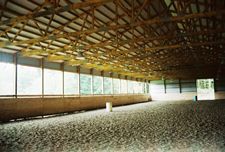I’ve designed probably a thousand indoor riding arenas in the past three decades. One thing I have never heard from a client is – my riding arena is just too big! As I have heard my lovely bride tell hundreds of people – the cost of building is having four corners, once you have them, you might as well place them as far apart as you can afford and have space.
If uncertain on what size riding arena is needed, do the “test before building” exercise. Mark off the dimensions of the arena – use cones, poles, round pen panels, bales, PVC pipe or even rope or a garden hose. Basically, just something to delineate the perimeter. Ride in the area for a week, which should give you a feel for if it is the right size. Always keep in mind the age and health of the horses that will be using the arena. Small circles are hard work on a horse’s legs and can lead to unsoundness.
I’ve seen people order 40’ x 60’ buildings for their“riding arena”. In reality a building this size, is hardly enough to cover a hot walker. Keep in mind, a standard riding round pen has a 66 foot diameter.
In most cases, the length of the arena should be at least twice the width. This makes sizes such as 60’ x 120’, 70’ x 140’, 80’ x 160’ and 100’ x 200’ very popular. This ratio allows a horse to “get up to speed” on the straight, and yet still be able to make the turn at the end of the arena.
 For formal dressage and practice riding dressage tests, one needs to know exactly where to do transitions and cueing. For this level of precision, a standard sized dressage arena is needed. A small dressage arena is 66’ x 132’, so this gives an idea of where to start for flatwork riding. If planning on setting up jumps or doing speed events then an expansion of those measures is needed, perhaps to a large dressage riding arena size which is 66’ x 197’.
For formal dressage and practice riding dressage tests, one needs to know exactly where to do transitions and cueing. For this level of precision, a standard sized dressage arena is needed. A small dressage arena is 66’ x 132’, so this gives an idea of where to start for flatwork riding. If planning on setting up jumps or doing speed events then an expansion of those measures is needed, perhaps to a large dressage riding arena size which is 66’ x 197’.
Arena sizes vary widely between disciplines. Working cows and reining typically requires the most room, an arena of 100’ x 200’ or longer. For calf roping 70’ x 240’ works, with a return chute. Most people who jump want a space at least 80 feet wide and 120 feet long, and prefer more space if possible.
For giving riding lessons or a professional doing a lot of showing, plan on 200 to 250 feet of length. Whatever the discipline, a horse requires about 60’ diameter to do balanced circles, so it really takes a minimum width of 70 to 75 feet to have some wall leeway on either side of a 60 foot circle.
When planning, consider most roof truss manufacturers prefer standard span dimensions, usually in increments of 10 feet. A standard small covered arena truss is 60’ wide. In most cases (other than higher snow loads), sets of trusses are usually and most affordably spaced 12 feet apart, creating standard covered arena lengths in 12 foot increments.
A commercial riding arena is best constructed bigger than you think you need. You may need to accommodate multiple disciplines or riding lessons simultaneously. A large arena also increases the number of potential buyers should you choose to sell sometime in the future. A large arena can always be partitioned off to create smaller spaces inside of it for lunging areas or dressage tests.
Once again, no matter how big you make it, sometime down the line I can pretty much guarantee you will come back to tell me…”I wish I had built it bigger”.






